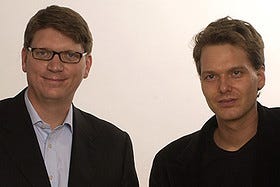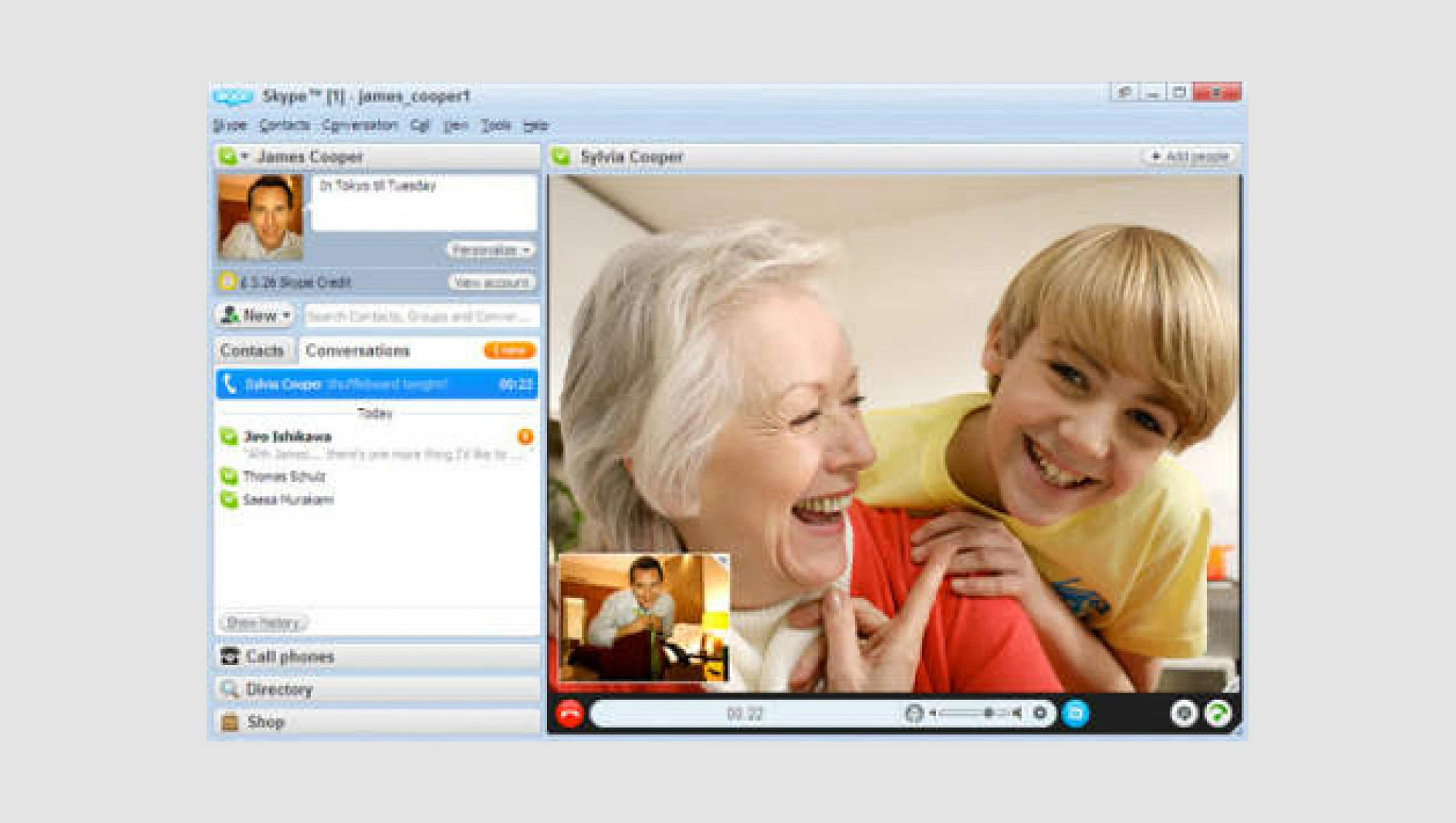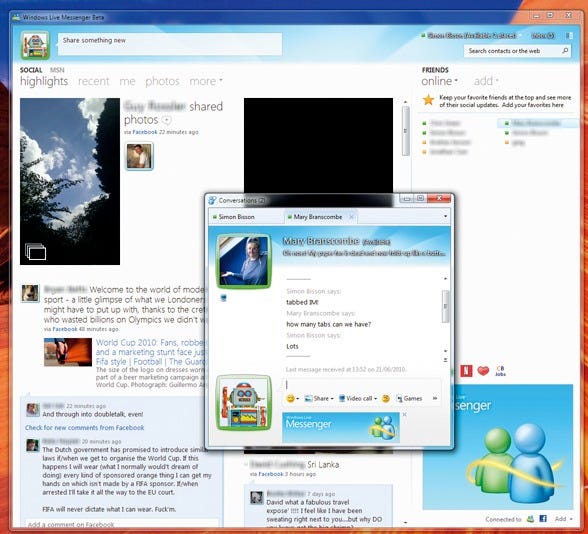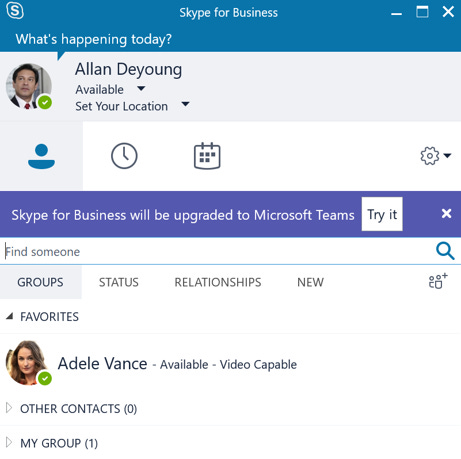Skype Was Finally Shutdown 2 Months Ago
Skype won the 2000s. Zoom won the 2020s. Here’s what happened in between.
Do you remember this?
There was a time when saying “Let’s Skype” felt as normal as saying “Let’s call.”
Back then, Skype was the way long-distance couples stayed in touch, families caught up across time zones, and remote teams got work done.
It made something expensive feel effortless. And for a while, it owned that space.
But today, Skype is being shut down, replaced by the very tools it helped inspire.
No, we aren’t going to talk about what went wrong.
Instead, let’s talk about what product teams can learn from Skype’s rise, its pivotal moments, and the decisions that led to its fade-out.
Let’s break it down.
Skype Take Off (2003–2006)
Skype was founded in 2003 by Niklas Zennström (Sweden) and Janus Friis (Denmark), the rebel entrepreneurs behind the file-sharing service Kazaa.
At the time, international calls were painfully expensive, Wi-Fi internet was spreading, and consumer webcams were just emerging.
So, they set out to fill this perfect market gap.
Using P2P networking hacks learned from Kazaa, they created Skype, so anyone with an internet connection can make voice calls to anyone else worldwide.
This P2P architecture meant no costly central servers. It routed calls through other users’ computers, making Skype cheap to operate with surprisingly high quality.
The product hit a nerve. Seeing the value and seamlessness Skype provided, it soon became the talk of the town.
So, when one user downloads Skype to call a friend abroad, that friend downloads it to call their family, and so on. Growth was viral and exponential.
Within the first day, 10,000 people tried Skype, and by 2004, it had over 1 million simultaneous users online at peak hours.
By late 2005, just two years after the market entry, Skype boasted 54 million registered users, and traditional telecoms were officially on notice.
Tech observers described Skype’s uptake as a hockey stick curve (truly explosive).
And soon, major milestones followed.
eBay acquired Skype in 2005 for $2.6 billion to connect buyers and sellers.
By 2006, Skype had over 100 million users, and it was adding around 380,000 new users per day by 2009.
In those early years, Skype became the first European tech company to reach a global scale in the internet era.
The perfect storm of circumstances, frustrated phone customers, broadband proliferation, and easy-to-use software, launched Skype into the stratosphere.
Product-Market Fit
Skype was deeply emotional for its users, not just a tech utility.
It’s hard to overstate how personally transformative it felt in the 2000s to see and hear someone far away without worrying about a massive phone bill.
Long-distance couples maintained relationships over Skype video dates. Parents could watch their overseas kids grow up through weekly calls.
Immigrants and expatriates bridged time zones to reconnect with family back home.
Voice quality often even surpassed landline calls, especially with a good headset or speakers, which made conversations feel more intimate.
In an era when a 5-minute overseas call was a luxury, Skype offered hours of face-to-face time for free. And that was a genuine lifeline back then.
Skype quickly became synonymous with staying in touch.
The verb “to Skype” has been in the Oxford dictionary since 2006. That shows how ingrained it had become. As one long-time user described,
“It was basically the only way we could be in contact – and for free. I don’t know what we would have done without Skype.”
- Source
Skype as a Platform (2007–2011)
By the late 2000s, Skype had evolved from a simple calling app into a full-fledged communication platform.
The team continuously added features that we take for granted today:
Text chat and file sharing (so you can send a quick hello or a photo during calls), SMS integration, and SkypeOut to call actual phone numbers at low rates.
In 2006, Skype introduced video calling, beating Apple’s FaceTime by four years. Suddenly, people could see each other while talking, straight from their PC.
In 2009, they introduced screen-sharing for remote demos and support.
Then, in 2010, they launched a group video call feature for virtual meetings and hangouts, and even experimented with real-time translations.
All of this was years before Zoom, WhatsApp, or Google Meet existed in their current forms. Skype became ubiquitous in everyday life.
Businesses used Skype for international customer support and job interviews, while journalists used Skype with call-recording plugins to conduct interviews.
Websites added “Skype me” buttons so customers could call a support agent via Skype. Niche communities adopted Skype as their hangout.
There were Skype-enabled cordless phones, webcams, and TV plugins. By 2010, Skype reported 660 million registered users and nearly 300 million monthly active users.
The service carried 25-40% of the entire world’s international calling minutes by the early 2010s, which terrified traditional telcos.
In 2011, the year Skype turned eight, it was by far the world’s largest international voice carrier, still growing.
That same year, upon seeing Skype’s central position in consumer communications, Microsoft made an $8.5 billion bet to acquire Skype.
Skype had become a platform and a verb, a tech titan of the 2000s. Little did we know, this would mark the peak of Skype’s power, and the beginning of its decline.
The Turning Point (2011)
When Microsoft acquired Skype in 2011, it was its largest acquisition at the time.
To Microsoft, Skype’s 170 million active users and strong brand seemed like the perfect weapon to compete with emerging rivals.
The plan was to weave Skype into everything: Windows, Office, Xbox, mobile phones, making it the backbone of Microsoft’s communication services.
Immediately, Microsoft made a bold (and controversial) move.
They decided to remove Windows Live Messenger, the company’s chat app, and migrate its hundreds of millions of Messenger users to Skype by 2013.
The idea was to have one unified consumer messaging platform under the Skype name. In hindsight, this was the first misstep in a series of strategic fumbles.
Folding Messenger into Skype, of course, grew Skype’s user base on paper, but it also burdened Skype with a broader identity than it ever had.
It was now supposed to be everyone’s everything (from text IM to landline replacement to video meeting tool).
The clarity of purpose that drove Skype’s early success began to blur.
Meanwhile, Microsoft simultaneously had an enterprise communication product called Lync (later rebranded Skype for Business in 2015) aimed at office use.
Skype’s brand got split into two:
A consumer Skype is run by one team, and
A “for Business” version run by the Office software team.
Each had different feature sets and priorities, and later on, Microsoft would introduce yet another overlapping product (Teams).
Internally, Skype’s champions were now dispersed, and focus was diluted. The Skype name remained famous, but its product vision became muddled.
Yes, Microsoft poured all resources into Skype, but not always in the right ways.
They integrated Skype with Outlook email and Xbox consoles, and even Skype’s audio chat powered Microsoft’s new Translator app.
Yet, over the next few years, Skype lost its plot on its core mission.
The turning point had arrived.
Under big-company ownership, Skype was about to face challenges it didn’t handle well, just as a new generation of competitors rose to seize the moment.
Tech Debt and Missed Mobile Era
One of Skype’s greatest strengths, its advanced P2P technology, became a technical challenge in the 2010s.
The peer-to-peer architecture that allowed Skype to scale cheaply in 2003 became challenging as the years passed.
By late in the decade, Skype had years of legacy code.
Even former insiders admitted that Skype had become “the epitome of technical debt” with “millions of lines of code,” which made it super hard to innovate quickly.
Microsoft eventually undertook a massive overhaul.
Around 2012–2013, they began shifting Skype from the old P2P network to a cloud-based architecture (more traditional client-server).
In theory, this would make adding features and syncing messages across devices easier. In practice, the transition was rocky.
Longtime users noticed changes in call quality and reliability. The once-solid voice calls started suffering from more lag and dropouts than before.
(Microsoft even had to drop support for some older devices during this transition, effectively cutting off users who couldn’t upgrade.)
The technical guts of Skype were being swapped out mid-flight, and it showed.
Meanwhile, Skype’s product direction went astray. Feature creep set in.
Perhaps jealous of trendy apps like Snapchat and WhatsApp, Skype’s team started piling on gimmicks and UI redesigns that nobody had asked for.
In 2017, Skype released a redesigned app to look “fresh” and attract younger users, with colorful emojis, story-style temporary video messages, bots, and GIFs.
The result was user outrage.
The new interface buried core functions like making a call under flashy extras. Soon, Skype’s average App Store rating fell from 3.5 stars to just 1.5 after the update.
Performance got worse, and the app felt bloated. Within a year, Microsoft had to backtrack, publicly apologising and undoing many of those changes.
But the damage was done. While Skype was busy cluttering its app with unwanted features, its competitors doubled down on simplicity and reliability.
Crucially, Skype missed the mobile revolution.
The 2010s were all about smartphones, and though Skype had mobile apps, they were often a step behind the competition.
Apps like WhatsApp focused on being mobile-first and lightweight, whereas Skype’s mobile app was often seen as sluggish and clunky.
That opened the door for others.
WhatsApp rolled out super-simple voice and video calls on mobile
FaceTime came bundled on every iPhone
New players like Zoom built an easy one-click video meeting experience in the late 2010s.
Users flocked to these specialized tools.
Skype’s attempt to be everything meant it ended up being not the best at any one thing. In short, Skype lost its product focus, and in doing so, lost its grip on users.
Internally, Microsoft’s attention was also moving elsewhere.
In 2016, Microsoft launched Teams, a new collaboration app, to compete with Slack and Zoom in the workplace. Teams quickly became a priority product for Microsoft.
That created a kind of internal cannibalization. Skype was still around, but Microsoft was funneling energy into the newer Teams platform (which, ironically, began to duplicate a lot of Skype’s functionality, but in a more integrated way).
Pandemic, Teams, and the Fade-Out (2020–2024)
In a poetic twist, 2020 should have been Skype’s big comeback.
When the COVID-19 pandemic hit, suddenly the entire world needed to video-call from home. That was exactly Skype’s original domain.
And indeed, there was a momentary bump. In March 2020, Skype’s usage spiked 70%, hitting about 40 million daily users during the lockdowns.
But any hopes that Skype would ride the remote-work wave were quickly dashed.
Zoom became the breakout star, growing from just 10 million users to 300 million daily meeting participants by April 2020.
Virtually overnight, “Zoom” became the default verb for video meetings, not Skype.
Microsoft’s priorities also undercut Skype’s chance. The company aggressively pushed Microsoft Teams for both businesses and consumers.
In the spring of 2020, even as Skype’s numbers rose briefly, Microsoft rolled out new Teams features and subtly nudged Skype users to try Teams for online gatherings.
Internally, Skype had already been deemed surplus.
From that point, Skype’s decline went from a slow drip to a fast bleed. By early 2021, Skype’s share of the video-call market had collapsed to just 6%.
Millions of remaining users switched to alternatives.
Families moved their group chats to Zoom
School teachers adopted Google Meet
Friends used FaceTime or WhatsApp
Even for international calling (once Skype’s bread and butter), people had largely moved on to apps like Viber, WeChat, or new unlimited phone plans.
During the pandemic, Skype’s monthly active users fell despite the surge in demand.
By 2023, Skype was averaging only 36 million daily users… from 40 million in 2020.
In contrast, Microsoft Teams rocketed to 250+ million monthly active users (with ~70 million daily by the end of 2020), and Zoom reported well over 200 million daily participants consistently. Skype was no longer even in the conversation – literally.
Finally, in February 2025, Microsoft made it official. Skype will be retired on May 5, 2025, and all users are encouraged to move to Microsoft Teams.
After 21 years, the Skype era had come to an end.
Lessons from Skype’s Rise and Fall
Skype’s journey offers rich lessons for tech companies and product leaders:
1. Do One Thing Well
Skype tried to do everything - video calls, chat, business meetings, even social features. But in doing so, it lost focus on what made it special, great video calling.
Meanwhile, Zoom stuck to one goal: easy, high-quality video meetings. And it nailed it.
It’s better to be great at one thing than average at many.
2. Keep Innovating or Fall Behind
Skype was first to market, and that helped it grow fast.
But once it got big, it stopped moving fast. While others added smart features like one-click join or mobile-first design, Skype lagged.
Being first isn’t enough. You have to keep evolving to stay ahead.
3. Upgrade Tech Without Breaking Things
When Skype shifted from peer-to-peer to the cloud, things broke. Calls got buggy, features disappeared, and users got frustrated.
Meanwhile, newer tools were built for the cloud from day one and worked better.
Modernize your tech, but do it carefully. Don’t lose users along the way.
4. Never Sacrifice User Experience
In 2017, Skype redesigned its app and made it confusing and cluttered. What people loved about Skype was how simple and reliable it felt. When that changed, they left.
Fancy features don’t matter if the core experience suffers.
5. One Product, One Strategy
After Microsoft bought Skype, it lost its place. It was split across teams and slowly pushed aside for Microsoft Teams. There was no clear owner. No clear focus.
A product needs a champion. Without one, it fades, even if millions use it.
Skype’s story is both inspiring and a warning.
It changed the world, making long-distance calls feel easy and free.
It helped build the always-connected world we now take for granted.
But it also shows this.
Even the most loved product can fall behind if it stops improving. Skype won the 2000s. Zoom won the 2020s. The difference? Product focus.
Skype didn’t lose because it was bad, but because others moved faster, listened better, and kept things simple. Its ringtone still brings back memories.
And its impact on how we talk, work, and connect will always be remembered.
That’s it for today.
Until next time,
Sid.








Great post . Skype was a great product, I don't find that any of the newer competitors match its simplicity or quality from the early days. Plus it helped me connect with family from afar so it has an emotional meaning. I have similar feelings about Yahoo! which had a line-up of fantastic and ahead-of-their-time products (a blog platform, a messenger with games that still beats any IM out there etc). Would be curious to hear your thoughts on the Yahoo! story too!
Loved it. I read and read it again :)
Lessons learnt was most enlightening part, I could resonate so well.